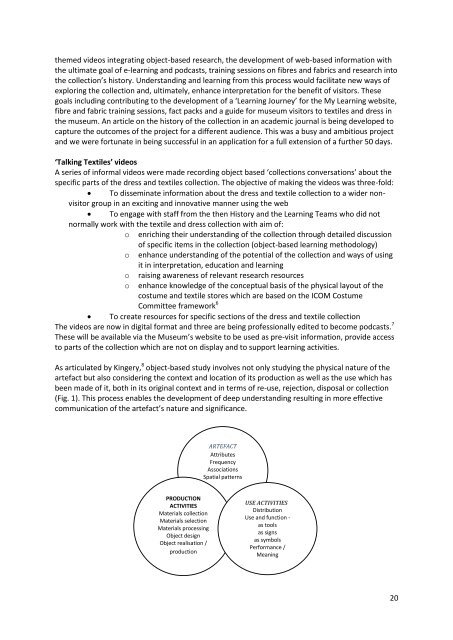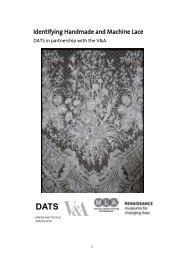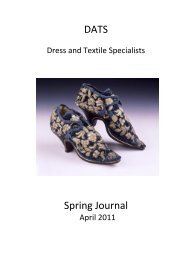Spring 2012 - Dress and Textile Specialists
Spring 2012 - Dress and Textile Specialists
Spring 2012 - Dress and Textile Specialists
You also want an ePaper? Increase the reach of your titles
YUMPU automatically turns print PDFs into web optimized ePapers that Google loves.
themed videos integrating object-based research, the development of web-based information with<br />
the ultimate goal of e-learning <strong>and</strong> podcasts, training sessions on fibres <strong>and</strong> fabrics <strong>and</strong> research into<br />
the collection’s history. Underst<strong>and</strong>ing <strong>and</strong> learning from this process would facilitate new ways of<br />
exploring the collection <strong>and</strong>, ultimately, enhance interpretation for the benefit of visitors. These<br />
goals including contributing to the development of a ‘Learning Journey’ for the My Learning website,<br />
fibre <strong>and</strong> fabric training sessions, fact packs <strong>and</strong> a guide for museum visitors to textiles <strong>and</strong> dress in<br />
the museum. An article on the history of the collection in an academic journal is being developed to<br />
capture the outcomes of the project for a different audience. This was a busy <strong>and</strong> ambitious project<br />
<strong>and</strong> we were fortunate in being successful in an application for a full extension of a further 50 days.<br />
‘Talking <strong>Textile</strong>s’ videos<br />
A series of informal videos were made recording object based ‘collections conversations’ about the<br />
specific parts of the dress <strong>and</strong> textiles collection. The objective of making the videos was three-fold:<br />
To disseminate information about the dress <strong>and</strong> textile collection to a wider nonvisitor<br />
group in an exciting <strong>and</strong> innovative manner using the web<br />
To engage with staff from the then History <strong>and</strong> the Learning Teams who did not<br />
normally work with the textile <strong>and</strong> dress collection with aim of:<br />
o enriching their underst<strong>and</strong>ing of the collection through detailed discussion<br />
of specific items in the collection (object-based learning methodology)<br />
o enhance underst<strong>and</strong>ing of the potential of the collection <strong>and</strong> ways of using<br />
it in interpretation, education <strong>and</strong> learning<br />
o<br />
o<br />
raising awareness of relevant research resources<br />
enhance knowledge of the conceptual basis of the physical layout of the<br />
costume <strong>and</strong> textile stores which are based on the ICOM Costume<br />
Committee framework 6<br />
To create resources for specific sections of the dress <strong>and</strong> textile collection<br />
The videos are now in digital format <strong>and</strong> three are being professionally edited to become podcasts. 7<br />
These will be available via the Museum’s website to be used as pre-visit information, provide access<br />
to parts of the collection which are not on display <strong>and</strong> to support learning activities.<br />
As articulated by Kingery, 8 object-based study involves not only studying the physical nature of the<br />
artefact but also considering the context <strong>and</strong> location of its production as well as the use which has<br />
been made of it, both in its original context <strong>and</strong> in terms of re-use, rejection, disposal or collection<br />
(Fig. 1). This process enables the development of deep underst<strong>and</strong>ing resulting in more effective<br />
communication of the artefact’s nature <strong>and</strong> significance.<br />
ARTEFACT<br />
Attributes<br />
Frequency<br />
Associations<br />
Spatial patterns<br />
PRODUCTION<br />
ACTIVITIES<br />
Materials collection<br />
Materials selection<br />
Materials processing<br />
Object design<br />
Object realisation /<br />
production<br />
USE ACTIVITIES<br />
Distribution<br />
Use <strong>and</strong> function -<br />
as tools<br />
as signs<br />
as symbols<br />
Performance /<br />
Meaning<br />
Discard / Refuse<br />
20





